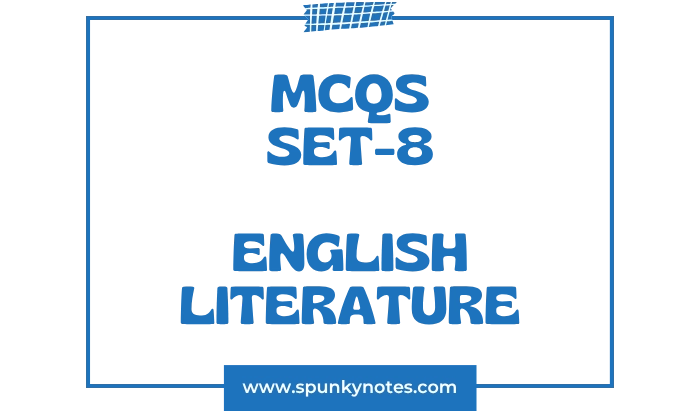

Estimated Reading Time: 16 min
English Literature MCQs
Set-8
1. In which of the Shakespearean comedies does the song “Sigh no more, ladies” occur?
A. As You Like It
B. Much Ado About Nothing
C. The Twelfth Night
D. A Midsummer Night’s Dream
2. The Pilgrims in Chaucer’s Prologue to the Canterbury Tales go to the pilgrimage to the tomb of:
A. St. Thomas A. Beckett
B. St. Paul
C. St. John
D. St. Peter
3. Spenser’s The Shepherd’s Calendar is called a calendar because:
A. It is a historical document
B. It predicts the seasons
C. It is a series of pastoral eclogues for every month of the year
D. It is written in a chronological style
4. The good Angel and evil Angel appear in :
A. Macbeth
B. Dr. Faustus
C. Hamlet
D. King Lear
5. In England, the theatres were closed in :
A. 1650
B. 1642
C. 1660
D. 1645
6. “An Horatian Ode upon Cromwell’s Return from Ireland” is written by :
A. John Milton
B. John Donne
C. Richard Lovelace
D. Andrew Marvell
7. Which of the following works of Dryden is a political satire?
A. Absalom and Achitophel
B. All for Love
C. Essay of Dramatic Poesy
D. Mac Flecknoe
8. Moliere’s Le Misanthrope has been adapted partly in …………………
A. The Man of Mode
B. The Plain Dealer
C. The Way of the World
D. The Country Wife
9. The Restoration comedy is known as ……………………
A. the comedy of humours
B. the comedy of manners
C. the sentimental comedy
D. the domestic comedy
10. ‘Pandemonium’ as described in The Paradise Lost is in ……………………
A. the heaven
B. the hell
C. the earth
D. the cosmos
11. In which famous poem do we find the lines: “Full many a gem of purest ray serene ……… / Full many a flower is born to blush unseen ………”?
A. ‘Ode to Evening’
B. “Elegy Written in Country Churchyard”
C. ‘The Deserted Village’
D. ‘The Task’
12. Who is the author of Moll Flanders ?
A. Jonathan Swift
B. Defoe
C. Richardson
D. Fielding
13. Who among the following popularised the heroic couplet?
A. John Milton
B. John Donne
C. Samuel Johnson
D. Pope
14. Who has written The Battle of the Books?
A. Alexander Pope
B. Jonathan Swift
C. Jonathan Swift
D. Joseph Addison
15. In whose plays do we find the anti-sentimental reaction ?
A. Wycherly
B. Richard Brinsley Sheridan
C. William Congreve
D. John Dryden
16. Wordsworth’s Prelude is :
A. an elegy
B. a ballad
C. Autobiographical poem
D. a lyric
17. “God made the country and man made the town.” Who wrote this line?
A. Alexander Pope
B. Cowper
C. Wordsworth
D. Thomas Gray
18. Who is the author of The Four Ages of Poetry?
A. S. T. Coleridge
B. Matthew Arnold
C. Lord Byron
D. Shelley
19. “It is a truth universally acknowledged that a single man in possession of good fortune must be in want of a wife.” In which novel of Jane Austen does this sentence occur?
A. Pride and Prejudice
B. Emma
C. Sense and Sensibility
D. Mansfield Park
20. “A thing of beauty is a joy forever.” A verse tale of Keats begins with this line. Identify the tale:
A. The Eve of St. Agnes
B. Endymion
C. Isabella
D. Lamia
21. “God is in his Heaven / All is right with the world !” In which poem do these lines occur ?
A. “Rabbi Ben Ezra”
B. “My Last Duchess”
C. “The Ring and the Book”
D. “Pippa Passes”
22. Which of the following arrangements of the authors is in the correct chronological order according to their dates of birth?
A. Thackeray, Browning, John Ruskin, Matthew Arnold
B. Thackeray, Browning, John Ruskin, Matthew Arnold
C. John Ruskin, Thackeray, Matthew Arnold, Browning
D. Matthew Arnold, John Ruskin, Thackeray, Browning
23. Which of the following author-book pairs is correct?
A. Idea of a University – John Newman
B. Culture and Anarchy – Thomas Arnold
C. Sartor Resartus – Matthew Arnold
D. Life of Johnson – Lord Macaulay
24. In which poem do the following lines occur: “Winter is come and gone / But grief returns with the revolving year.”
A. The Scholar
B. The Scholar Gípsy
C. Thyrsis
D. Dover Beach
25. Which of the following novels is called a “Novel without a Hero”?
A. Middlemarch
B. Vanity Fair
C. Oliver Twist
D. David Copperfield
26. To which genre does The Murder in the Cathedral belong?
A. Tragedy
B. Melodrama
C. Closet Drama
D. Poetic Drama
27. “Nothing has changed since I began; / My eye has permitted no change.” These lines are from :
A. Seamus Heaney’s “Digging”
B. Ted Hughe’s “Hawk Roosting”
C. Philip Larkin’s “The Whitsun Weddings”
D. W. B. Yeats’ “The Second Coming”
28. Scrutiny was an influential journal edited by :
A. F.R. Leavis
B. T.S. Eliot
C. I.A. Richards
D. Matthew Arnold
29. Leopold Bloom and Molly are characters in :
A. James Joyce’s Ulysses
B. T.S. Eliot’s The Waste Land
C. W.B. Yeats’ The Second Coming
D. Virginia Woolf’s Mrs. Dalloway
30. “The apparition of these faces in the crowd: / Petals on a wet, black bough.” The above lines are an example of the following literary movement :
A. Surrealism
B. Futurism
C. Vorticism
D. Imagism
31. The term kitchen sink drama applies to the works of:
A. Arnold Wesker
B. John Osborne
C. Shelagh Delaney
D. John Arden
32. Which of the following is not a non-fictional work by V.S. Naipaul?
A. The Middle Passage
B. India: A Wounded Civilization
C. An Area of Darkness
D. A House for Biswas
33. Which of the following comes under the category of the campus novel ?
A. The Mill on the Floss
B. Middlemarch
C. Lucky Jim
D. A Portrait of the Artist as a Young Man
34. Name the Irish poet who has received the Nobel Prize :
A. Derek Mahon
B. Michael Longley
C. Seamus Heaney
D. Paul Muldoon
35. Which of the following is not written by Iris Murdoch?
A. The Red Sea
B. A Severed Head
C. The Sea, The Sea
D. Under the Net
36. The Last Labyrinth is a novel by :
A. R. K. Narayan
B. Arun Joshi
C. Bhabani Bhattacharya
D. Manohar Malgonkar
37. Chinua Achebe’s Things Fall Apart is a novel set in:
A. South Africa
B. Nigeria
C. Ghana
D. Kenya
38. Karnad’s Hayavadana is a play based on :
A. Greek myth
B. Thomas Mann’s Transposed Heads
C. Local Kannada folklore
D. The Mahabharata
39. Summer in Calcutta is a volume of poems by :
A. Nissim Ezekiel
B. Kamala Das
C. A. K. Ramanujan
D. Dom Moraes
40. Which of the following novels is by Patrick White?
A. Voss
B. The Eye of the Storm
C. The Solid Mandala
D. Riders in the Chariot
41. Edward Said’s Orientalism is related to the following field of studies :
A. Post-colonial
B. Feminist
C. Marxist
D. Structuralist
42. Who distinguished between the primary and secondary imagination?
A. I. A. Richards
B. S.T. Coleridge
C. William Wordsworth
D. John Keats
43. The New Critics believed that the literary text is :
A. a self-contained unit and is made up of only knowledge
B. merely a cultural product
C. only a reflection of society
D. mainly biography
44. Name the writer who is associated with Reader Response theory
A. Cleanth Brooks
B. Stanley Fish
C. I. A. Richards
D. T. S. Eliot
45. The terms ‘writerly and readerly texts’ were used by
A. Jacques Lacan
B. Roland Barthes
C. Michel Foucault
D. Jacques Derrida
46. Alliteration is the repetition of:
A. Consonant sounds
B. Vowel sounds
C. Metaphor
D. Imagery
47. Show the rhyme scheme of Terza rima.
A. abba abba cde cde
B. abab cdcd efef gg
C. aba, bcb, cdc
D. abab bcbc cdc
48. Dactyl is a metre with:
A. one stressed syllable followed by two unstressed syllables
B. two stressed syllables
C. two unstressed syllables followed by a stressed syllable
D. one stressed syllable followed by one unstressed syllable
49. Free verse or vers libre is :
A. characterized by a fixed metrical pattern
B. not based on any metrical pattern
C. written in heroic couplets
D. always rhymed
50. Shakespearean sonnet uses the following rhyme scheme :
A. abba cddc effe gg
B. abab, cdcd, efef, gg
C. abba abba cde cde
D. abab cdcd efef gh
Overview
This set of 50 multiple-choice questions begins with the Renaissance and the Medieval periods, covering authors such as Shakespeare, Chaucer, Spenser, and Marlowe.
The quiz then moves to the 17th century, focusing on Andrew Marvell, John Dryden, Milton, and Restoration comedy. Defoe, Pope, and Swift represent the 18th century.
The Romantic period is tested with questions on Wordsworth, Shelley, Keats, and Jane Austen. The Victorian era follows, with authors such as Browning, Thackeray, and Matthew Arnold.
The 20th century is well covered, including Modernists such as T.S. Eliot, James Joyce, and Ted Hughes. It also features post-war writers like John Osborne and Seamus Heaney. The list includes postcolonial figures such as Chinua Achebe and Kamala Das.
The final section shifts to literary theory, testing concepts from Coleridge, Roland Barthes, and Edward Said. It also tests technical knowledge of poetic devices, including alliteration, terza rima, and sonnet structures.


